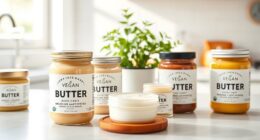As a packaging enthusiast, I’ve always been fascinated by the evolution of different industries. And when it comes to butter packaging, the changes have been truly remarkable. From humble beginnings to modern innovations, the way we package butter has come a long way.
In this article, we will explore the historical development, current trends, and the growing importance of sustainability in butter packaging. Join me as we delve into the world of butter packaging and discover the challenges and opportunities that lie ahead.
Key Takeaways
- Historical development of butter packaging includes the use of animal bladders, wooden or ceramic containers, wax paper, and metal tins/glass jars.
- Current trends in butter packaging focus on sustainable materials, minimalist design, storytelling, and targeting eco-conscious consumers.
- Packaging innovations for sustainable butter packaging include biodegradable wrappers, plant-based materials, compostable options, and recycled paper.
- Alternatives to plastic packaging, such as paper, corn starch, bamboo, and compostable materials, offer viable options to reduce environmental impact.
Historical Development of Butter Packaging
The historical development of butter packaging has greatly influenced the way we package and preserve dairy products today. Looking back at the evolutionary timeline of butter packaging, we can see how it has evolved to meet the changing needs and preferences of consumers.
In ancient times, butter was often stored in animal bladders or animal skins. This method of packaging allowed for easy transportation and preservation. As societies became more advanced, containers made of wood or ceramic were used to store butter. These containers were not only functional but also reflected the cultural influences of the time.
In the 19th century, the invention of the butter churn revolutionized the process of making butter. With the increased production, innovative packaging solutions were developed. Butter was often wrapped in wax paper or placed in wooden boxes. These methods helped to extend the shelf life of butter and ensure its freshness.
Fast forward to the 20th century, and we see the introduction of butter packaging in metal tins and glass jars. This allowed for mass production and distribution of butter on a larger scale. However, it wasn’t until the 1950s that the use of plastic packaging became popular. Plastic containers provided a more convenient and cost-effective option for both manufacturers and consumers.
The historical development of butter packaging has paved the way for current trends in butter packaging, which focus on sustainability and eco-friendliness. Transitioning away from single-use plastic, many companies are now using biodegradable or compostable materials for butter packaging. This shift reflects the growing awareness of environmental concerns and the desire to reduce waste.
Current Trends in Butter Packaging
One of the current trends in butter packaging is the use of eco-friendly materials. As consumers become more conscious of their environmental impact, packaging design has evolved to meet their demands.
Here are three key trends in butter packaging:
-
Sustainable Materials: Brands are increasingly using materials that are biodegradable, compostable, or made from recycled sources. This not only reduces the environmental footprint but also appeals to eco-conscious consumers.
-
Minimalist Design: Simple and clean packaging designs have gained popularity in the butter industry. Minimalist packaging not only looks sleek and modern but also communicates a sense of quality and purity to consumers.
-
Storytelling: Brands are using packaging as a tool to tell their story and connect with consumers. By sharing their values, origins, and production processes, butter brands can create a deeper connection with consumers and differentiate themselves in the market.
These trends in butter packaging are not only environmentally friendly but also align with effective marketing strategies. By using sustainable materials, adopting minimalist designs, and incorporating storytelling, butter brands can attract and retain customers who are increasingly conscious of their purchasing choices.
In the subsequent section, we will explore packaging innovations for sustainable butter packaging.
Packaging Innovations for Sustainable Butter Packaging
As I delve into the topic of sustainable butter packaging, I am excited to explore the key points of biodegradable butter wrappers, eco-friendly packaging solutions, and the reduced carbon footprint associated with these innovations.
It is fascinating to see how the industry is moving towards more environmentally friendly options, such as using biodegradable materials for butter wrappers, which can break down naturally and reduce waste.
Additionally, the development of eco-friendly packaging solutions not only addresses the need for sustainability but also promotes a positive impact on the environment by reducing the carbon footprint associated with the production and disposal of packaging materials.
Biodegradable Butter Wrappers
Biodegradable butter wrappers are becoming increasingly popular due to their eco-friendly nature. As consumers become more aware of the environmental impact of traditional packaging materials, there has been a growing demand for biodegradable alternatives. These wrappers are made from sustainable materials that can break down naturally over time, reducing waste and minimizing harm to the environment.
-
Made from plant-based materials: Biodegradable butter wrappers are often made from renewable resources such as cornstarch or sugarcane. These materials are derived from plants and can be replenished, making them a more sustainable choice.
-
Decomposes without harmful residue: Unlike traditional plastic wrappers, biodegradable alternatives decompose without leaving harmful residue behind. This means that they can be safely disposed of and will not contribute to pollution or harm wildlife.
-
Reduces carbon footprint: By choosing biodegradable butter wrappers, consumers can help reduce their carbon footprint. These wrappers require less energy and resources to produce compared to traditional packaging materials, further supporting sustainability efforts.
Overall, the increasing popularity of biodegradable butter wrappers reflects a growing commitment to finding sustainable solutions for packaging in the food industry.
Eco-Friendly Packaging Solutions
Eco-friendly packaging solutions are gaining traction in the food industry as consumers become more conscious of their environmental impact. With the increasing demand for sustainable packaging options, brands are exploring various eco-friendly materials to meet these needs. These materials include biodegradable plastics, compostable materials, and recycled paper.
To give you a better understanding of the different eco-friendly packaging options available, here is a table that compares four sustainable packaging solutions:
| Material | Description |
|---|---|
| Biodegradable | Breaks down naturally without harming the environment |
| Compostable | Can be turned into nutrient-rich compost |
| Recycled Paper | Made from recycled paper waste |
| Plant-based | Derived from renewable resources like corn or sugarcane |
These eco-friendly packaging materials not only reduce waste and minimize carbon footprint but also provide viable alternatives to traditional packaging methods. As consumer demands for sustainability continue to rise, it is crucial for businesses to adopt these sustainable packaging solutions to meet the expectations of environmentally-conscious consumers.
Reduced Carbon Footprint
To reduce your carbon footprint, consider using sustainable packaging materials that break down naturally and can be turned into nutrient-rich compost. Sustainable practices such as using eco-friendly packaging can have a significant impact on reducing carbon emissions. Here are three ways to achieve a reduced carbon footprint through sustainable packaging:
-
Use biodegradable materials: Opt for packaging made from materials like paper, cardboard, or plant-based plastics. These materials break down naturally and reduce the environmental impact.
-
Encourage carbon offsetting: Support companies that participate in carbon offsetting programs. These initiatives help neutralize carbon emissions by investing in projects that reduce greenhouse gases.
-
Optimize packaging design: Streamline packaging design to minimize waste and use less material. This reduces the carbon emissions associated with production, transportation, and disposal.
Environmental Impact of Butter Packaging
When it comes to packaging options, finding alternatives to plastic is crucial for reducing our environmental impact.
In this discussion, we will explore various biodegradable packaging options that can serve as viable substitutes for traditional plastic packaging.
Alternatives to Plastic
There’s been a growing demand for sustainable packaging options as people become more aware of the environmental impact of plastic. Consumers are seeking alternatives that are more environmentally friendly and can be easily recycled or composted.
In response to this demand, the packaging industry has been exploring various options to replace plastic. Here are three alternatives to plastic packaging:
-
Paper packaging: Paper is a popular choice for packaging due to its recyclability and biodegradability. It can be made from renewable resources, such as trees, and is easily recyclable in most recycling programs.
-
Plant-based alternatives: There are innovative packaging materials being developed from plant-based sources, such as corn starch, sugarcane fibers, and bamboo. These materials are renewable, compostable, and have a lower environmental impact compared to traditional plastic.
-
Compostable packaging: Compostable packaging is designed to break down into natural components when exposed to composting conditions. It offers a sustainable solution for packaging, as it reduces waste and can be turned into valuable compost for plants.
These sustainable packaging options provide viable alternatives to plastic, reducing the negative impact on the environment. However, there are also biodegradable packaging options that offer additional benefits in terms of decomposition and environmental impact.
Biodegradable Packaging Options
You can explore biodegradable packaging options that provide additional benefits in terms of decomposition and environmental impact.
When it comes to sustainable design, compostable materials are gaining popularity due to their ability to break down naturally and quickly without leaving harmful residues in the environment. These materials are typically made from renewable resources like plant-based polymers or natural fibers, such as cornstarch, bamboo, or sugarcane.
Unlike traditional plastics, biodegradable packaging can be composted at home or in industrial composting facilities, reducing the amount of waste that ends up in landfills.
Consumer Preferences and Butter Packaging
Consumers nowadays prefer butter packaging that is eco-friendly and easy to use. In today’s market, consumer behavior plays a significant role in shaping packaging design trends. As a knowledgeable analyst in the industry, I have observed three key factors that influence consumer preferences when it comes to butter packaging:
-
Sustainable Materials: Consumers are increasingly conscious of the environmental impact of their choices. They favor packaging made from biodegradable or recyclable materials, such as paperboard or compostable plastics. This aligns with their desire to reduce waste and contribute to a more sustainable future.
-
Convenience and Functionality: Consumers appreciate packaging that is easy to open, close, and reseal. Butter packaging with user-friendly features, like tear strips or resealable lids, offers convenience and ensures the product remains fresh. This addresses the practical needs of consumers who seek hassle-free experiences in their daily lives.
-
Visual Appeal: Packaging design plays a crucial role in capturing consumer attention. Vibrant colors, attractive graphics, and clear product information help consumers make informed choices. Eye-catching designs can also evoke positive emotions and create a strong brand association, influencing purchasing decisions.
Understanding these consumer preferences is essential for brands and manufacturers to stay competitive in the butter packaging market. By incorporating sustainable materials, ensuring convenience and functionality, and creating visually appealing designs, brands can meet the evolving needs and desires of today’s consumers.
The Future of Butter Packaging: Challenges and Opportunities
To stay ahead in the butter packaging market, it’s important for brands and manufacturers to anticipate the challenges and seize the opportunities that lie ahead.
The future of butter packaging presents both challenges and market opportunities. One of the main challenges is the increasing demand for sustainable packaging solutions. Consumers are becoming more conscious of their environmental impact and are actively seeking products with minimal packaging waste. This presents an opportunity for brands to innovate and develop eco-friendly packaging options such as biodegradable or recyclable materials.
Another challenge is the need for convenience and functionality in butter packaging. Consumers are looking for packaging that is easy to open, resealable, and keeps the butter fresh for longer. Manufacturers can capitalize on this by developing packaging designs that meet these requirements, providing added value to consumers.
Additionally, the growing trend of online shopping and home delivery services presents an opportunity for brands to optimize their packaging for e-commerce. This includes ensuring that the packaging is sturdy enough to protect the butter during transportation while also being compact and lightweight to minimize shipping costs.
Frequently Asked Questions
How Does Butter Packaging Affect the Shelf Life of the Product?
Butter packaging has a significant impact on the shelf life of the product. The choice of packaging materials plays a crucial role in maintaining the freshness and quality of butter. Proper packaging can protect the butter from exposure to air, light, and moisture, which can accelerate spoilage.
Packaging materials with good barrier properties, such as aluminum foil or airtight containers, can help extend the shelf life by preventing the entry of oxygen and moisture that can cause rancidity and mold growth.
What Are Some Alternative Materials Used in Sustainable Butter Packaging?
When it comes to sustainable butter packaging, alternative materials and innovative designs are key. Companies are constantly seeking new solutions that reduce waste and environmental impact.
From plant-based plastics to compostable materials, a range of options are being explored. These advancements not only address sustainability concerns, but also offer improved functionality and shelf life for the product.
Are There Any Regulations or Standards in Place for Butter Packaging?
There are regulations and standards in place for butter packaging. These guidelines ensure that the packaging materials used are safe for consumers and the environment.
The regulations may vary depending on the country or region, but generally focus on aspects such as food safety, labeling requirements, and environmental impact.
Compliance with these regulations and standards is crucial in maintaining the quality and sustainability of butter packaging.
Can Butter Packaging Be Recycled?
Yes, butter packaging can be recycled. It is important to choose packaging made from biodegradable materials that can easily break down and be recycled. By selecting sustainable packaging options, we can help reduce environmental impact and promote a circular economy.
Recycling options for butter packaging may vary depending on your local recycling facilities, so it is important to check with your local municipality or waste management company for specific guidelines.
How Can Consumers Reduce Their Environmental Impact When It Comes to Butter Packaging?
To reduce my environmental impact when it comes to butter packaging, I can focus on two key areas: reducing waste and choosing sustainable options.
By being mindful of the amount of packaging I use and opting for products with minimal or eco-friendly packaging, I can help minimize the amount of waste generated.
Additionally, considering alternatives like reusable or compostable packaging can further contribute to a more sustainable approach.
Conclusion
In conclusion, the evolution of butter packaging has come a long way. From simple paper wraps to modern sustainable solutions, current trends in packaging emphasize convenience and functionality while addressing environmental concerns. Innovations such as biodegradable materials and minimalist designs have paved the way towards a more sustainable future.
However, the journey towards truly sustainable butter packaging is far from over. As consumers become more conscious of their choices, the industry must rise to the challenge of creating packaging that is both eco-friendly and appealing.
The future of butter packaging holds both challenges and opportunities. It is up to us to make the right choices for a greener tomorrow.



